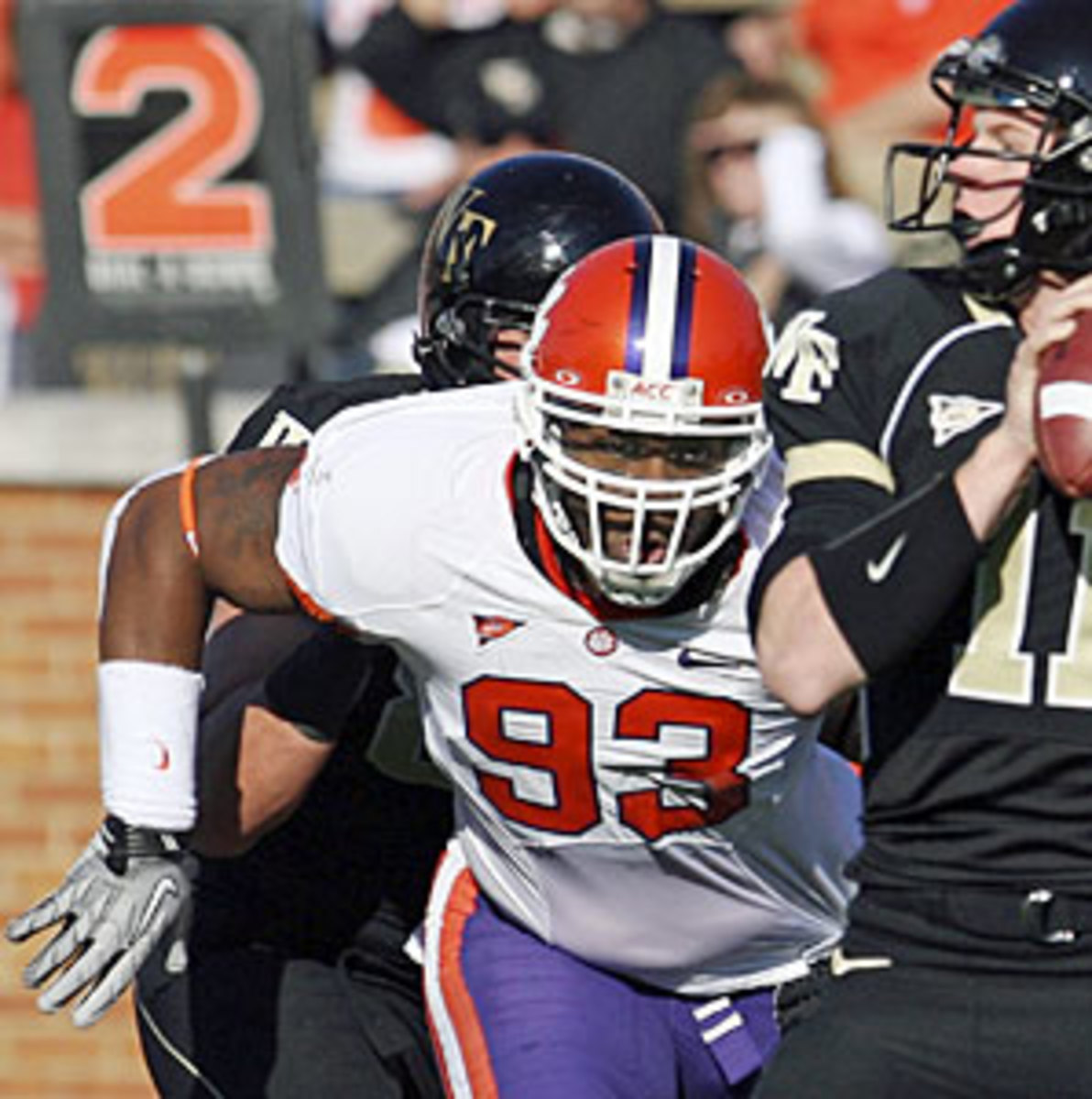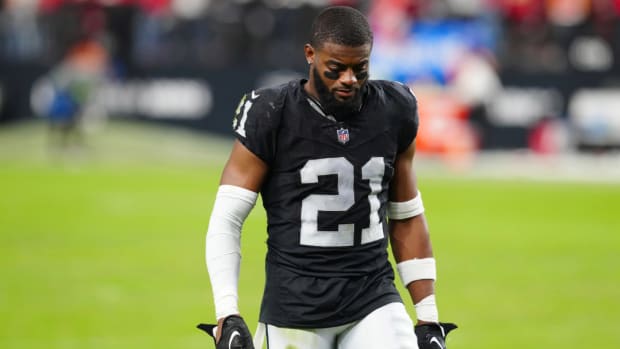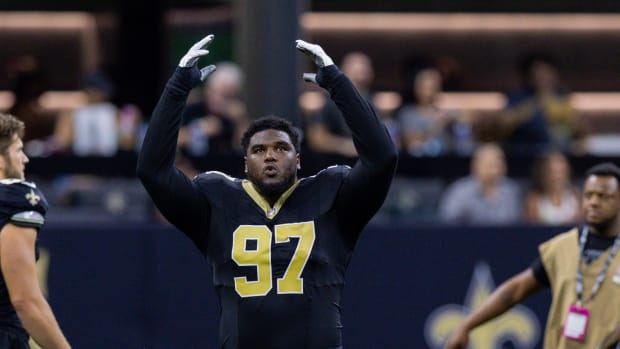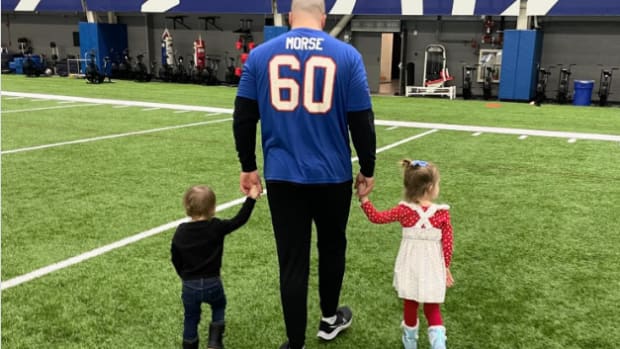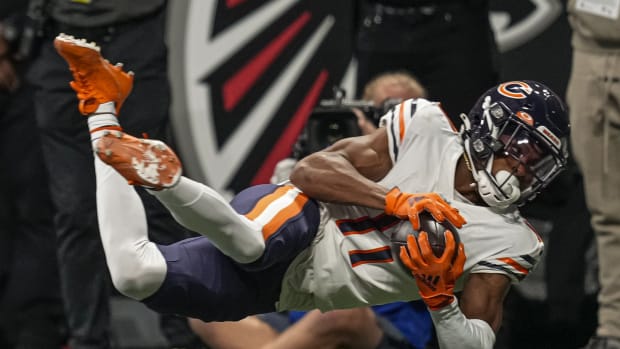Health questions altering draft stock of handful of prospects
One voice teams are listening to more and more are those of the trainers and doctors who have evaluated the health of players. Injury risk is one thing for an NFL team, but acquiring that risk at the high prices of the first round is something most teams want to avoid. "Injuries are the biggest risk for bust," one NFL scout told me. "There are always going to be the things you can't predict but you can't get hit for something you can and keep a job in this league."
These 10 players have the kind of risk that can kill the hopes of a GM or a team. All of them have been checked and re-checked, with many returning to Indianapolis in the last month for the little known but important medical re-check. On talent, each of these players is a first round pick, some at the very top of the draft, but each could drop some slots and some dollars based on how teams assess their injuries. With the help of several NFL talent evaluators and some top doctors, here are the issues surrounding these injury risks:
Thought at one point to be a possible No. 1 overall talent, Bowers' knees didn't pass the inspection of any team. Some worry he'll lose speed or need to be a passing-down only player -- and those are the ones that like him. Several teams have Bowers red-flagged, meaning that their medical staff would not sign off on the player being picked at all, let alone high in the draft. Let's be clear -- Bowers did not have microfracture in January, but the surgery he did have certainly points to degenerative problems, making it possible that Bowers would lose both speed and explosiveness both now and in the future. Teams playing on artificial turf seem especially concerned about Bowers. The best fit would be a team in the mid-20s willing to take a chance on Bowers, especially if they have a history with returning players from the procedure. Many have Bowers as a near-lock to Tampa at 20, but the Bucs lack the experience with the procedure. A better fit would be Philadelphia at 23 or Seattle at 25. He would be an absolute risk if he went anywhere near a No. 12 slot to Minnesota.
The principle of scarcity alone forces teams to reach for players. They see a need, have a GM fall in love with a player. In this draft, there could be as many as six "Blind Side" tackles taken. That's not a surprise, given the focus on the position in the modern NFL, but it does make many wonder why Dallas seems focused on Tyron Smith at No. 9. Smith is coming off knee surgery in December, and when he wasn't ready to participate at the combine in February, it raised some concerns. An extra month of rehab allowed Smith to put up solid Pro Day numbers, but there are still concerns about future knee problems due to his rapid weight gain and the surgery. Smith played behind Charles Brown, who couldn't crack the Saints lineup, making many wonder if Jerry Jones will really use his pick on an unglamorous lineman, especially one that's not a left tackle by experience.
NFL teams have a perfect comparable for Julio Jones' foot problems and that's helping Jones' draft stock immensely. "He's got almost the exact same issue that Michael Crabtree had coming into the draft," said a doctor familiar with Jones' injury and the surgery he had to correct it. "He was able to show good speed and productivity both before and after the procedure." "Teams have been able to see Jones both at the combine, where he ran a 4.39 with a broken bone, and some teams have traveled to see him run during his rehab process. He is already running, thought not quite at full speed. He will be good to go well before camps are scheduled to open this summer."His combination of speed, size and strength, as well as a productive career at Alabama make him sure to be no lower than the second WR taken, and some question whether or not he's better than A.J. Green. There's no reason for Jones to drop, with the Rams slot (No. 14) being his safety net. He's much more likely to go No. 6 to the Browns or No. 10 to the Redskins.
Running backs aren't sexy picks any more, but the Heisman Trophy winner remains one of few backs that teams are looking at to change their running game immediately. If Ingram had come out after his Heisman campaign, maybe he'd go higher, because injuries suffered in his junior season have only dropped him. Ingram had his knee scoped early in the season, but didn't seem to have any issues once he came back. The knee got a thumbs up from Bama team physician James Andrews, which is good enough for most teams. The knee is more an excuse for passing on any RB than it is a real knock on Ingram. The 4.62 40 is the real concern (4.5 at his Pro Day) and why Ingram looks to slip to the Pats at No. 28 if the Dolphins pass on him at No. 15.
Enough teams need a QB that there's a lot of movement in the lower part of the first round right now. One of the names that teams are trying to move to get is Ponder. He's being considered there only after extensive checks on his shoulder and elbow. Ponder had three surgeries on his arm during his final two seasons in Tallahassee, including two minor surgeries on his elbow and one major one on his shoulder. Ponder's helped a bit by Sam Bradford, who had a very similar procedure and great results in his rookie campaign. It's a good comparison, in that Ponder is more likely to re-injure the shoulder, but almost any QB driven into the ground would have the same problem, proclivity or not (see: Romo, Tony). Ponder could be the next Bills QB if he slides into the second round, but teams are looking to move into either the Pats' No. 28 slot or even the Eagles' No. 23 slot to pick a QB.
Teams got a quick lesson when they started looking at Clayborn, learning what Erb's Palsy is and how it might affect Clayborn. The injury is caused at birth and damages the brachial plexus. One way of looking at this is that we have one other condition that causes brachial plexus problems in the NFL: stingers. "If you consider how many players deal with stingers and adjust, it's hard to see how this would be a problem for [Clayborn]," said one doctor who examined Clayborn at the combine. The intermittent issues that he has didn't stop him in high school or college. "He was durable in the Big Ten," said one scout who admits he thinks the issue is actually a positive for Clayborn. "This kid worked through something that would have stopped most from even getting on the field. I have to love that work ethic." Clayborn could go as high as No. 20 to the Bucs, but he won't go any lower than the Packers at No. 32, where he would pair well with Clay Matthews in the pass rush.
"If I needed him to pitch, I'd be worried." That was the assessment of one scout who loves Heyward, who seems to be dropping on many boards. Heyward tore the ulnar collateral ligament in his elbow, known as the "Tommy John" ligament. While this is a common injury in baseball pitchers (and occasionally in quarterbacks), it's not a major problem for ends. A doctor that regularly performs this surgery in baseball told me there should be no long term concerns over and above the risk a normal DE would have -- "and how often does this happen to them?" he asked. Heyward's pedigree -- he's the son of Craig "Ironhead" Heyward -- helps as well. "Hard for me to question his genes or his toughness," said one scout. Heyward wasn't overly reliant on strength to begin with, so any team with a 3-4 scheme and an outside need will be in the mix on Heyward. He could go as high as No. 24 to the Saints, but it's more likely that he falls to the later picks in the first round (Jets or Packers) and possible that he slides to the Bengals in the second round.
At 6-4, 337, Phil Taylor's feet have a lot to hold up, but they've done so. Reports of a foot condition that has red-flagged him have been murky, but Taylor doesn't have a condition that required re-check. "There's concern," one scout said, "but it's about whether he'll hold up, not where he is now." Foot and knee problems are huge for players carrying as much raw tonnage as Taylor, but his bulk and good hands have several teams taking a look at the bottom of the first round. Comparisons to Kris Jenkins make many think that the Jets will take him at No. 30, but the risks that come with a big guy do seem to be weighing (no pun intended) on GMs. Taylor seems to be one of the guys that teams want to get into the top of the second round to get. All those calls late Thursday night could be for teams looking for Taylor.
Murray did everything as a Sooner except stay healthy. He spread the pain around, having hamstring, ankle, knee and shoulder injuries during his 2010 season. He was durable enough to leave with a lot of Oklahoma records, but his long-term durability is the big concern for teams. "He's a changeup back, not a feature back," said one scout. "What I'm not sure of is which half of a committee he is." He's neither big and bruising, nor is he small and shifty. More than one scout called him a "tweener," which says as much about the state of NFL running backs as it does about Murray. In the right system and surrounded with the right personnel, Murray should be productive. The Saints would be a great fit, but are unlikely to take him at No. 24. The Falcons might see him as a replacement for Jerious Norwood at No. 27, but it's more likely that his durability will push him into the second round.
While he sounds like a Batman villain, Dowling was more the arch-enemy of ACC offensive coordinators over the past few seasons. The only thing that hurt him was being hurt. Hamstring and ankle problems limited Dowling to only five games for the Cavs, but he put himself back in the mix for a first round selection with solid speed (4.40 at the combine) even though he strained his hamstring doing so. Scouts compare him regularly to former UVA standout Chris Cook, but the durability concerns trump his solid cover and good tackling skills. "Bigger receivers and harder hits make me think the injury problems are only going to get worse," said one scout who was high on Dowling prior to the combine. There's a small chance Dowling could be a reach in the later rounds, with some connecting him to the Ravens at No. 26. He's much more likely to be in the middle of the second round, with teams like Houston and Pittsburgh hoping the injury concerns slide him down to them.
Rudolph is the top TE on the board for most teams heading into the draft. He has size and speed that many compare to Dallas Clark, but like Clark, there are durability issues. He missed much of the '10 campaign after tearing the hamstring away from the bone. His 4.8 Pro Day 40 addressed many concerns, but looking back at Rudolph's career show more issues beyond the hamstring. He missed games in '09 with a shoulder problem, and going all the way back to high school, he's missed time in almost every season he's played. Several scouts say he's "stupid tough," which is a backhanded complement in scout-speak. Most of Rudolph's injuries come when he's trying to play through something. That makes him a gamer up to the point he's out for the season. You'll hear comps to Rob Gronkowski, who missed much of his last college season as well, but Rudolph is more like Oakland's Zach Miller in both size and speed. Teams at the back of the first round don't seem to have need, but he won't drop past the Rams in the second round.
































